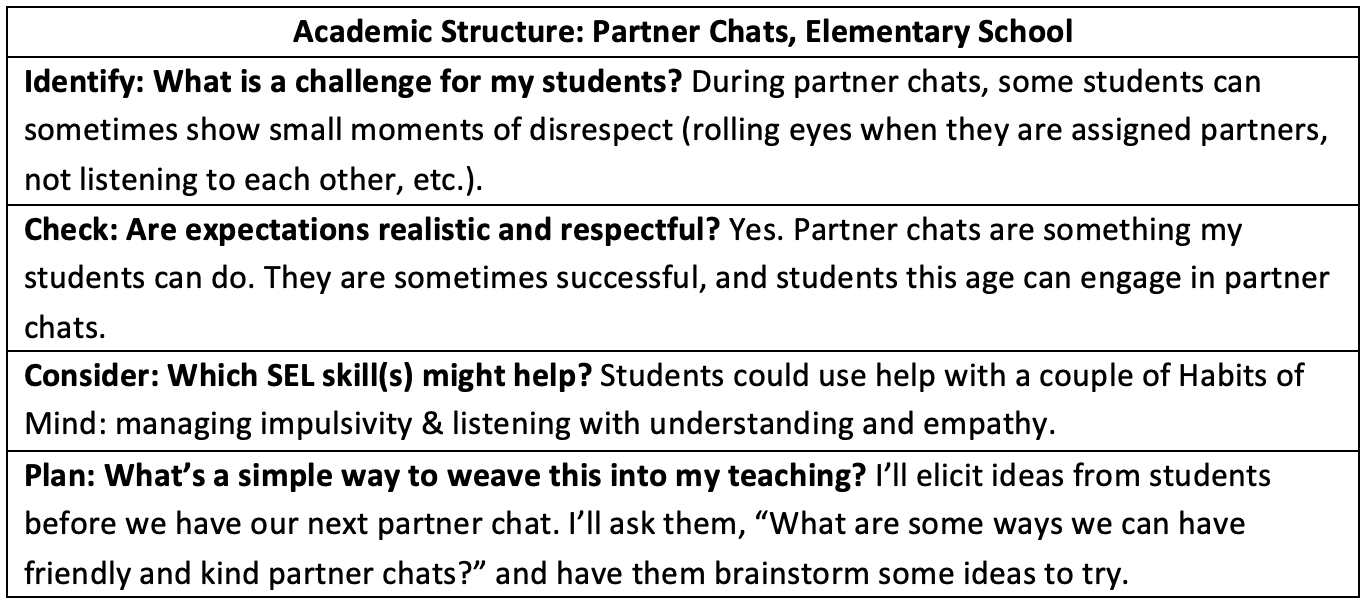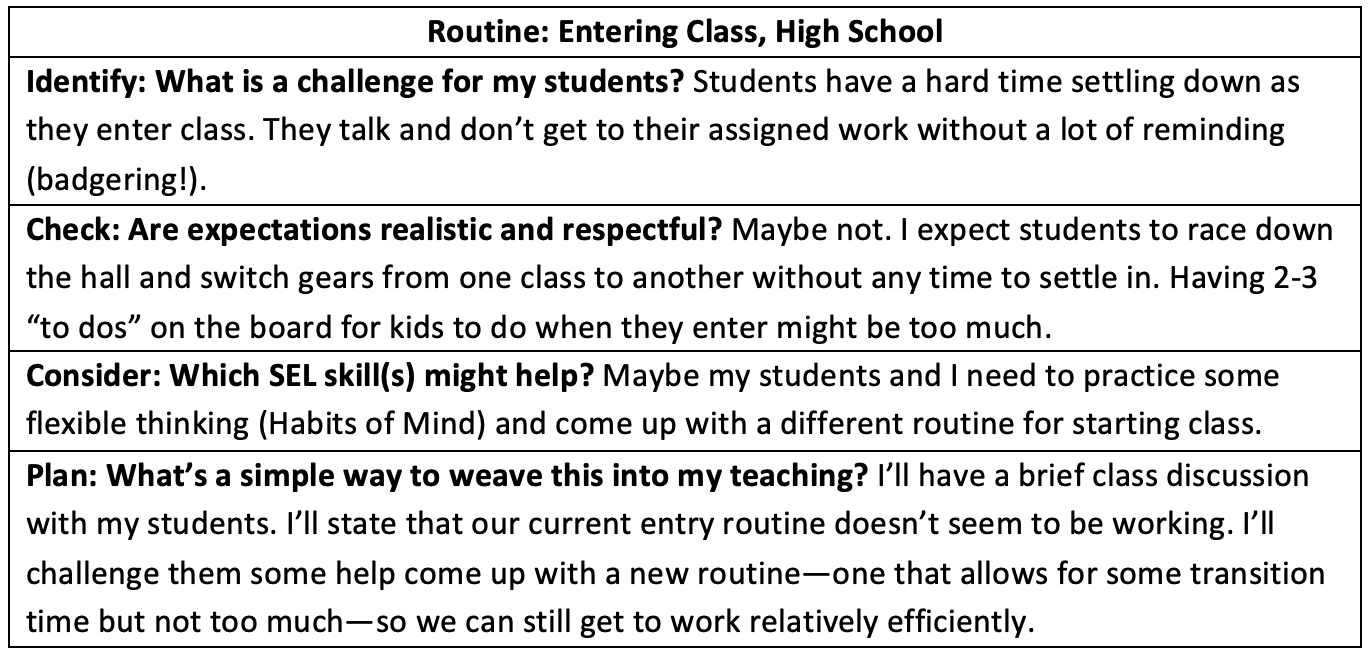Weave SEL Into Your Daily Teaching: A 4-Step Process
It is now widely recognized that social-emotional learning (SEL) should be an integral part of teaching and learning in schools. Yet it sometimes feels so overwhelming. SEL is just so…BIG. How do you know where to start?
Some districts purchase stand-alone SEL programs, which can provide some good ideas for lessons and activities, but they don’t always line up with what your students actually need in the moment. After all, kids’ social and emotional needs don’t typically show up in a nice tidy scope and sequence. We need to be more responsive if we want to best support our students effectively. Not to mention, who has time to teach SEL as a separate curriculum?
Don't hang your hat on scripted #SEL programs. Kids’ social and emotional needs don’t show up in a tidy scope and sequence. We need to be more responsive. Besides, who has time to teach SEL as a separate curriculum?
Mike Anderson Tweet
Here’s a 4-step process that can help you plan how to weave the teaching of SEL right into what you and your students are already doing. FYI—this process involves (perhaps) a bit of a mindset shift. Traditional classroom management systems often view challenges in the classroom through the lens of changing kids’ behaviors. Instead, this process focuses on helping them learn skills. This is a big difference. (To learn more about this shift, check out my new book: Tackling the Motivation Crisis: How to Activate Student Learning Without Behavior Charts, Pizza Parties, or Other Hard-to-Quit Incentive Systems.)
Step 1: Identify a time that’s challenging for your students.
What’s a time that your students are struggling? Or, what’s a time you anticipate a struggle? Maybe it’s a routine that’s a bit rocky—kids are jostling and pushing as they enter your room. Perhaps your students are getting too off-topic when they’re supposed to be talking about academic content. Maybe a student is taking too long in the bathroom—avoiding an assignment that feels challenging. Or perhaps you’re about to start a big class project, and you anticipate that your students might struggle with time management.
Especially the first few times you try this process, I recommend tackling something fairly simple and straightforward. This will help you wrap your head around how the process works. Once you’re familiar and comfortable with it, you might take on a more complex challenge.
Step 2: Ask yourself, “Are my expectations realistic and reasonable?”
Sometimes the problem lies primarily with the expectations, not with the students.
For example, once my fifth graders were really struggling with going to their cubbies during transitions. They couldn’t seem to put away writing notebooks and get out math journals without conflict and goofiness. I realized that too many cubbies were jammed into one corner of the room. Once I spread the cubbies out, transitions were smooth and easy (or at least more so).
Here are a few other common unrealistic or disrespectful expectations we may have in our classrooms or in our schools:
- Walking silently in the halls: If adults can’t do it, it’s probably not reasonable for kids. Instead, consider having students walk quietly—keeping voices low enough so that learners in other classrooms can stay focused.
- Bathroom breaks that are too short: If it takes 30 seconds to walk to the bathroom (and 30 seconds to walk back), a 3-minute bathroom break is unrealistic. What if a kid needs to poop? They shouldn’t have to ask for extra time—that could be embarrassing and even feel dehumanizing.
- Expecting quiet attention for too long: Especially early in the year, make sure you’re not expecting students to sit and listen for too long. Lengthy lessons create student dysregulation. Break lessons up into shorter chunks and make sure kids are getting lots of movement and chances to talk and work.
If you decide that your expectations are both realistic and respectful, move on to the next step. If not, adjust your expectations. Then head onto the next step and consider how you might still help set students up for success with your new adjusted expectations.
Step 3: Consider: What SEL skills might help your students be more successful?
Chances are, if expectations are reasonable, and students are struggling, there are some social skills or emotional skills that they’re either lacking or not using. What are they? You might be able to picture the scene in your mind and the skills just jump out at you. Kids are getting too silly during a game? They’re probably struggling with self-control. Students aren’t listening to each other during writing conferences? They might need some help with basic interpersonal skills such as making eye contact and asking clarifying questions.
It might be that you need some help coming up with some ideas about social and/or emotional skills students need. Here are a few resources you might consider.
- If you have an SEL framework that has been adopted by your school, district, or state, that’s a great place to start. For example, New Hampshire has a set of work-study practices that might give you some ideas for SEL skills kids need.
- The Habits of Mind framework is a phenomenal set of skills that have stood the test of time. For over 25 years, these have been used in classrooms and schools around the world to guide social and emotional skill development.
- The Collaborative for Academic, Social, and Emotional Learning (CASEL) has a great interactive wheel of SEL competencies that can help you generate ideas. (When you click on that link, scroll down a bit and try clicking on the sections of the wheel to get ideas for more specific SEL skills you might teach.)
Step 4: Plan a simple way to teach the SEL skill(s) that your students need when they need it.
Now that you know what your students need, think of how you’re going to help students learn that social or emotional skill. Keep it simple and weave it right into the setting where students need the help.
You might simply share a strategy for them to try. For example, if a student is getting distracted by peers where they’re working, you might say, “Devan, you might want to find a work spot that’s quieter—maybe over by the window or near the fish tank.”
Perhaps you want to jog students’ memories or have them share ideas with the class, you might elicit ideas from students—like I do in this video to help 3rd graders have successful partner chats.
If your students need more scaffolding than that—they need to see it, try it, and reflect on it—try modeling. This is a tried-and-true strategy that can work with all ages of learners.
Putting it All Together
So, there you have it–a 4-step process to help you weave the teaching of SEL into the daily fabric of the school day.
Check out the examples below to see how this looks when you put it all together. Notice that these plans are short and simple. I encourage you not to overthink this process as you plan.
If you’re interested, here’s a simple planning template you can use: Weave SEL Planning Guide.



Author
-
Mike Anderson has been an educator for many years. A public school teacher for 15 years, he has also taught preschool, coached swim teams, and taught university graduate level classes. He now works as a consultant providing professional learning for teachers throughout the US and beyond. In 2004, Mike was awarded a national Milken Educator Award, and in 2005 he was a finalist for NH Teacher of the Year. In 2020, he was awarded the Outstanding Educational Leader Award by NHASCD for his work as a consultant. A best-selling author, Mike has written ten books about great teaching and learning. His latest book is Rekindle Your Professional Fire: Powerful Habits for Becoming a More Well-Balanced Teacher. When not working, Mike can be found hanging with his family, tending his perennial gardens, and searching for new running routes around his home in Durham, NH.
- Share:
You may also like

The Perfect Breakfast for Teachers
- February 11, 2025
- by Mike Anderson
- in Blog

Finding Time for a One-on-One Problem-Solving Conference


